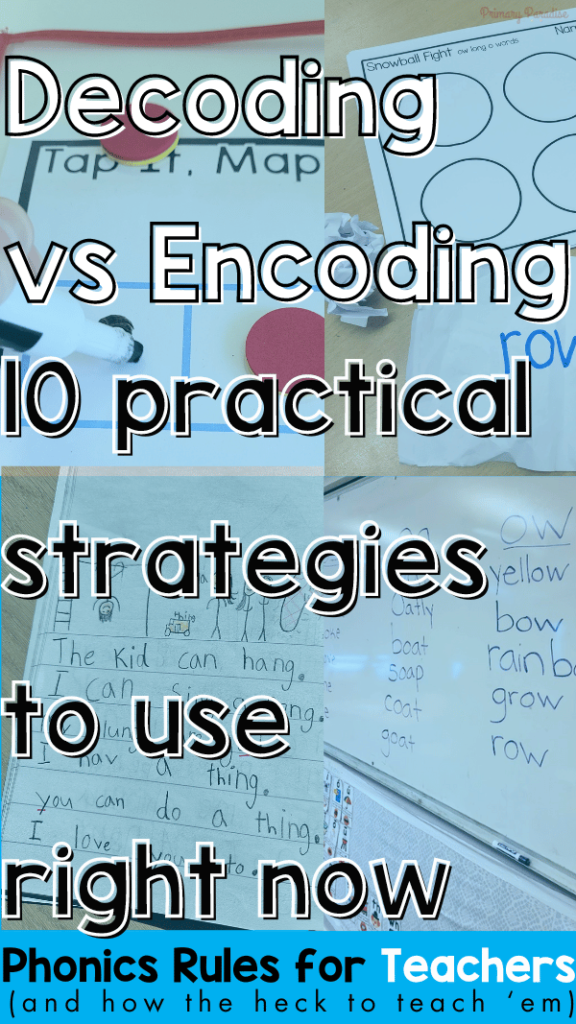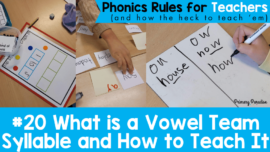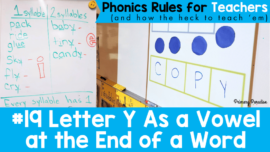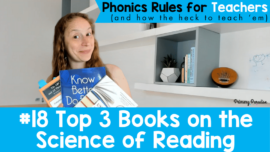Encoding and decoding are two connected but different skills. While both of these skills are important, understanding the difference between the two is crucial to good literacy instruction. If you can pinpoint whether a struggling student need to work on their encoding or decoding skills, you can better target your phonics, reading, and writing instruction. Let’s examine what encoding and decoding are, how students learn each, and how to strengthen your students’ encoding and decoding skills.
This is post 7 in my series Phonics Rules for Teachers (and How the Heck to Teach ‘Em). If you’d like to see previous posts, you can click here.
Would you rather listen or watch? Find a podcast version of this blog post or watch the video below.
What is Decoding?
Decoding is the process of converting symbols (letters) to sounds. Simply put, decoding is the process of reading words. When you look at a book and say (either out loud or in your head) the words on the page, that is decoding. While reading involves comprehending, or understanding what we read, decoding refers to the part where we see c-o-w and can say “cow”.
In order to be able to decode, students need to understand many things. First, they need to understand that letters represent sounds, and they need to be able to produce those sounds. Then, they need to understand which letters represent which sounds, and then slide all of those sounds together to say a word. As students decode more and more complex words, they will also need to understand that letters and letter combinations (graphemes) can represent multiple sounds. AND, they need to be able to look at a word and determine quickly which sound certain letters are representing. For example: you can decode these two words: pool and book which both have the spelling pattern “oo” but are pronounced differently. You can decode giraffe and goat and know that one has a soft g and one has a hard g.
What does the process of decoding look like?
As adults, we decode automatically for most words. For students learning to read, their brain needs to do a lot more work to go through each step of the process.
The process of decoding requires students to:
- hear and produce the sounds in a language (phonetic awareness)
- recognize that letters represent sounds (phonics)
- connect specific sounds to the letters that represent them (phonics)
- recognize spelling patterns and produce those sounds (orthographic awareness)
- blend those sounds together to say words
What is Encoding?
Encoding is the opposite of decoding. Encoding is the process of of converting sounds to symbols. Simply put, encoding is the process of writing words. When we say a sentence out loud like “I can jump” and then write down the letters that correspond to those sounds, that is encoding. Of course, when we are writing, we need to understand the meaning behind what we write, encoding is the part of writing where we turn sounds into letters on paper (or screen).
In order to encode, students need to understand many of the same things they need to understand when they decode. They need to understand that we can represent sounds with symbols and which symbols represent which sounds and when. Encoding also requires students to know how to write a letter, actually, physically forming it, while holding in their brain the word they are trying to spell. While encoding often comes automatically to adults, it requires a large amount of cognitive work for children who are just learning to read and write.
What does the process of encoding look like?
As adults, we also encode automatically for most words. For students learning to write, their brain needs to do a lot more work to go through each step of the process.
The process of decoding requires students to:
- hear the individual sounds in a word (phonetic awareness)
- recall which letters represent each sound (phonics)
- write down the symbol(s) for each sound while holding the rest of the word/sentence in their mind (orthographic awareness)
- properly form each letter so it is readable and clear
- look at what they wrote to check that it is correct (orthographic awareness and phonics)
Why do students need strong decoding and encoding skills?
It is vital for students to develop strong decoding and encoding skills so they can be successful readers and writers. While comprehension, grammar, and vocabulary, are also important, students simply can not read or write unless they can decode and encode.
How do decoding and encoding skills support each other?
While decoding and encoding are opposites, they are also skills that are intertwined. Both decoding and encoding require students to have a strong phonetic awareness (the ability to hear, break apart, and put together oral sounds), phonics awareness (the rules of the language), and orthographic awareness (the spelling of a language). As a teacher, you often see students who have stronger decoding skills or stronger encoding skills, but overall, students develop this skills at a relatively equal pace.
When we teach our students using a structured literacy approach, we focus on developing decoding and encoding skills at the same time. For example, students practice reading short vowel words AND writing short vowel words within the same literacy lesson. Focusing on both decoding and encoding will help your students become strong readers and writers.
How to Foster Strong Decoding and Encoding Skills
Let’s take a look at 10 specific ways to foster strong decoding and encoding skills in your students.
Sound Drill Warm Up
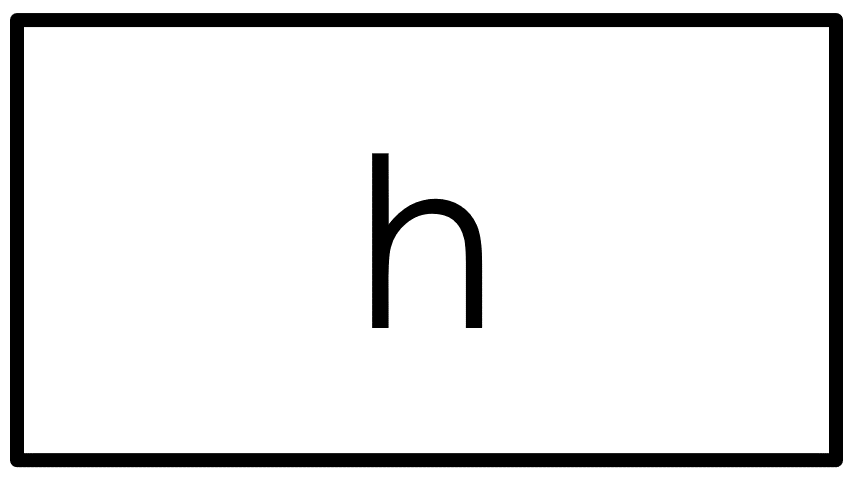
This is one of my favorite ways to develop strong decoding skills in students in a few minutes each day. At the beginning of your phonics lesson, take 2-3 minutes to do a sound drill with your students. Create a very simple Google Slides or PowerPoint and put one letter or spelling pattern on each slide. As you click through the slides, students produce the sound(s) the spelling patterns represent. You can either group vowel sounds and consonant sounds together, or ask your students to stand up for vowel sounds and sit for consonant sounds. As they learn new sounds, add them to the warm up slides. And, if a sound makes more than one sound, you can add a small 2 or 3 to indicate how many sounds that letter can represent. For example, S can represent /s/ and /z/ so once students learn both sounds, they can say both sounds for the drill.
Decodable Texts

Use decodable texts that only use sounds and spelling patterns that have been explicitly taught. This will foster strong decoding skills. It also will help students focus on the text to decode as opposed to trying to guess since the text uses sounds they have learned. I like to use these decodable readers as well as decodable partner plays.
Fluency Passages

When students are learning to decode, we want them to work towards fluency. Fluency requires automaticity, or reading words quickly without having to sound them out. A great way to develop this is by using decodable fluency passages. Students can read the passage multiple times to develop comfort with the text.
Purposeful Read Alouds
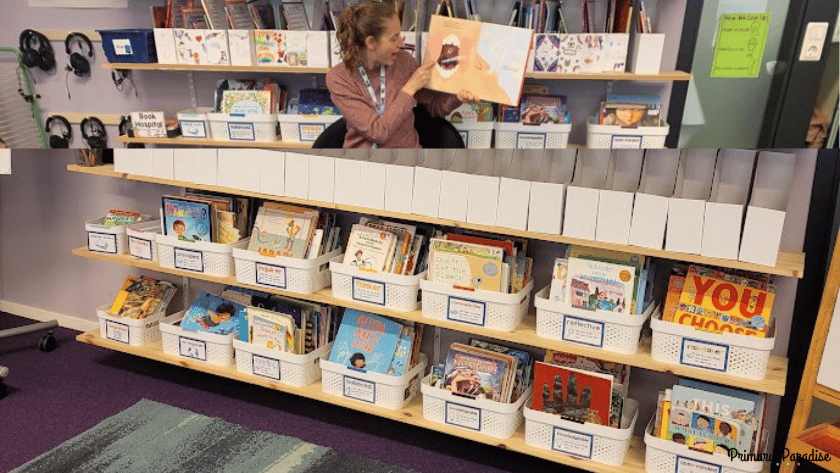
Reading books out loud to your students is a great way to foster strong decoding skills. Listening to expressive, fluent reading has many benefits including increasing vocabulary, comprehension, and fluency skills. In addition, when you are reading aloud, you can model decoding words. Of course students benefit from listening to smooth, fluent reading. But, you can also stop throughout the book and purposefully choose some words to decode together. Perhaps you can choose words that have sounds you’re currently focusing on, sounds you’ve noticed students struggling with, or just sounds that you’ve already learned.
Word Mapping

Word mapping helps students learn words and connect spelling patterns to the sounds they represent. It is a great strategy for developing encoding skills. You can read an in-depth explanation of how to map words here. As you’re using this strategy, have students identify which letters are representing vowel sounds and which letters are representing consonant sounds.
Teach Syllable Types

Teaching students the characteristics of the 6 syllable types will help them develop both their decoding and encoding skills. I written a great deal about why it’s important to teach the six syllable types and how to teach them in recent post.
Snowball Fight

Snowball Fight is one of my favorite games that works on decoding and encoding. Every student writes a single word on 3 pieces of paper. Here, we were learning the long o ow spelling, so they had to pick long o ow words. Then, they crumple up their paper to make snowballs. In the count of 3, everyone throws their snowballs. Next, everyone gathers three snowballs. They open them up, read the words, and then write them on the recording sheet. You can even have them write a sentence instead of just the word. They crumple up those snowballs again and play another round. It’s a great way to focus on a specific sound, and the students love it because it gets them up and moving.
Musical Sentences
This is another favorite activity that focuses on both decoding and encoding. I place a decodable sentence at each student’s spot. The sentences are face down. Each sentence will have a word or words that contain the spelling pattern we’re currently focusing on. Students walk around the tables with a white board and marker. I play music and when the music stops, they flip over the sentence, read it out loud, and then write down the word/s that have the spelling pattern we’re focusing on.
Targeted Journal Entries

After you’ve introduced a new sound and spelling and you’ve spent some time working with it, have your students complete a targeted journal entry. This is a great way to practice encoding. First, make a list of words you know with the spelling pattern. Have the students help you tap out the words and focus on the sounds they hear and spelling them correctly. Then, ask students to write a sentence (or more than one depending on the age) in their journal using at least one word with that spelling pattern.
In the beginning, they can just write 1 or 2 sentences, and they don’t need to connect. The goal is to just use the sound in words in context. For example, if you’re learning about the aw and au spelling patterns, they might write, “I saw a cat. She hauls the trash.” As they advance, you can encourage students to begin to connect the sentences so they make sense. For example, “He paused the show. He wanted to draw what he saw.”
Modeled Writing

Model encoding skills using phonics knowledge. You can do this during writing lessons, but it also is a perfect opportunity during other lessons like science and social studies. If you’re students are going to need to write about a topic, and you are modeling the expectations, have them help you encode some of the words in your sentences.
